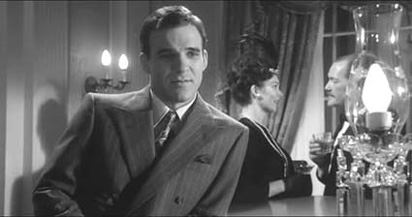Hidden Gems: Dead Men Don't Wear Plaid
By Stephanie Star Smith
July 5, 2005
BoxOfficeProphets.com

Martin's next project was Dead Men Don't Wear Plaid, a film that trod the experimental path to an even greater degree than Pennies From Heaven, if that can be believed. However, on paper, Dead Men seemed more likely to score with audiences, as Martin paired with Carl Reiner on the script, and Reiner took the reins of the film. Dead Men Don't Wear Plaid was a film noir parody that incorporated scenes from many real '30s and '40s noir films; it played straight with the noir conventions whilst satirizing the melodramatically- serious tone that was the hallmark of the genre. And while audiences still didn't flock to see the film, Dead Men Don't Wear Plaid was much more successfully realized that Pennies From Heaven, and a damned fine and funny film to boot.
Where Dead Men succeeded was in not relying solely on its gimmick to carry the film. The script was written not in support of the film tricks to be employed, but to stand on its own as a parody, with the special effects used in service of the story rather than the other way around. The story of a private eye hired by a beautiful woman to track down her father and uncovering a Nazi plot in the process was strong enough and humorous enough in its own right to make for a great popcorn flick; adding the noir film clips was the proverbial icing.
And the gimmick itself was utilized perfectly; instead of creating some sort of F/X to make the stars in the clips mouth dialogue written for the story, the actual dialogue from the original scenes was employed to advance the plot of Dead Men Don't Wear Plaid. And Steve Martin, who was the only actor appearing in the borrowed scenes, was inserted into the action in such a way as to blend into the original sequence whilst keeping the almost-unavoidable cognitive dissonance to a minimum. So when Fred MacMurray is talking to the blonde in Double Indemnity, the turnaround shows Steve Martin instead of Barbara Stanwyck. When Bogie makes that phone call in The Big Sleep, he gets Steve Martin on the other end. The genius of the script is in tailoring these scenes so that Martin advances the plot with his dialogue yet is still interacting with the stars in the clips, which are largely intact. Thus, what could have been an out-and-out disaster, with the older sequences being shoehorned into Dead Men Don't Wear Plaid without care or attention, instead turns into a wisely-employed device that meshes seamlessly with the rest of the film's action. Add in the fact that the movie never forgets it's supposed to be funny, and you have a unique method of filmmaking that turned out a pretty good product.
Sadly, audiences weren't any more impressed with Dead Men Don't Wear Plaid than they were with Pennies From Heaven, and the film didn't fare well at the box office. But with the advent of home video, audiences now have a chance to catch this clever and entertaining film that richly deserves far more attention than it got during its theatrical release.